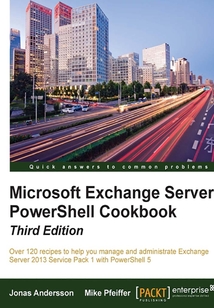舉報 

會員
Microsoft Exchange Server PowerShell Cookbook(Third Edition)
最新章節:
Index
Thisbookisformessagingprofessionalswhowanttobuildreal-worldscriptswithWindowsPowerShell5andtheExchangeManagementShell.IfyouareanetworkorsystemsadministratorresponsibleformanagingandmaintainingExchangeServer2013,youwillfindthishighlyuseful.
目錄(168章)
倒序
- 封面
- 版權信息
- Credits
- About the Authors
- About the Reviewers
- www.PacktPub.com
- Preface
- Chapter 1. PowerShell Key Concepts
- Introduction
- Using the help system
- Understanding command syntax and parameters
- Understanding the pipeline
- Working with variables and objects
- Working with arrays and hash tables
- Looping through items
- Creating custom objects
- Using debugger functions
- Understanding the new execution policy
- Working with Desired State Configuration
- Using the Save-Help function
- Working with script repositories
- Chapter 2. Exchange Management Shell Common Tasks
- Introduction
- Manually configuring remote PowerShell connections
- Using explicit credentials with PowerShell cmdlets
- Transferring files through remote shell connections
- Managing domains or an entire forest using the recipient scope
- Exporting reports to text and CSV files
- Sending SMTP e-mails through PowerShell
- Scheduling scripts to run at a later time
- Logging shell sessions to a transcript
- Automating tasks with the scripting agent
- Scripting an Exchange server installation
- Chapter 3. Managing Recipients
- Introduction
- Adding modifying and removing mailboxes
- Working with contacts
- Managing distribution groups
- Managing resource mailboxes
- Creating recipients in bulk using a CSV file
- Working with recipient filters
- Adding and removing recipient e-mail addresses
- Hiding recipients from address lists
- Configuring recipient moderation
- Configuring message delivery restrictions
- Managing automatic replies and Out of Office settings for a user
- Adding modifying and removing server-side inbox rules
- Managing mailbox folder permissions
- Importing user photos into Active Directory
- Chapter 4. Managing Mailboxes
- Introduction
- Reporting on the mailbox size
- Working with move requests and performing mailbox moves
- E-mail notification on mailbox moves
- Importing and exporting mailboxes
- Deleting messages from mailboxes
- Managing disconnected mailboxes
- Reporting on mailbox creation time
- Setting storage quotas for mailboxes
- Finding inactive mailboxes
- Detecting and fixing corrupt mailboxes
- Restoring deleted items from mailboxes
- Managing public folder mailboxes
- Reporting on public folder statistics
- Managing user access to public folders
- Chapter 5. Distribution Groups and Address Lists
- Introduction
- Reporting on distribution group membership
- Adding members to a distribution group from an external file
- Previewing dynamic distribution group membership
- Excluding hidden recipients from a dynamic distribution group
- Converting and upgrading distribution groups
- Allowing managers to modify group membership
- Removing disabled user accounts from distribution groups
- Working with distribution group naming policies
- Working with distribution group membership approval
- Creating address lists
- Exporting address list membership to a CSV file
- Configuring hierarchical address books
- Chapter 6. Mailbox Database Management
- Introduction
- Managing the mailbox databases
- Moving databases and logs to another location
- Configuring the mailbox database limits
- Reporting on mailbox database size
- Finding the total number of mailboxes in a database
- Determining the average mailbox size per database
- Reporting on database backup status
- Restoring data from a recovery database
- Chapter 7. Managing Client Access
- Introduction
- Managing ActiveSync OWA POP3 and IMAP4 mailbox settings
- Setting internal and external CAS URLs
- Managing the Outlook Anywhere settings
- Blocking Outlook clients from connecting to Exchange
- Reporting on active OWA and RPC connections
- Controlling ActiveSync device access
- Reporting on ActiveSync devices
- Chapter 8. Managing Transport Servers
- Introduction
- Managing connectors
- Configuring transport limits
- Allowing application servers to relay mail
- Working with custom DSN messages
- Managing connectivity and protocol logs
- Searching message tracking logs
- Working with messages in transport queues
- Searching anti-spam agent logs
- Implementing a header firewall
- Configure the Edge Transport server role
- Chapter 9. High Availability
- Introduction
- Building a Windows NLB cluster for CAS servers
- Creating a Database Availability Group
- Adding mailbox servers to a Database Availability Group
- Configuring Database Availability Group network settings
- Adding mailbox copies to a Database Availability Group
- Activating mailbox database copies
- Working with lagged database copies
- Reseeding a database copy
- Using the automatic reseed feature
- Performing maintenance on Database Availability Group members
- Reporting on database status redundancy and replication
- Chapter 10. Exchange Security
- Introduction
- Granting users full access permissions to mailboxes
- Finding users with full access to mailboxes
- Sending e-mail messages as another user or group
- Working with Role Based Access Control
- Creating a custom RBAC role for administrators
- Creating a custom RBAC role for end users
- Troubleshooting RBAC
- Generating a certificate request
- Installing certificates and enabling services
- Importing certificates on multiple Exchange servers
- Chapter 11. Compliance and Audit Logging
- Introduction
- Managing archive mailboxes
- Configuring archive mailbox quotas
- Creating retention tags and policies
- Applying retention policies to mailboxes
- Placing mailboxes on Retention Hold
- Placing mailboxes on In-Place Hold
- Performing a discovery search
- Configuring administrator audit logging
- Searching the administrator audit logs
- Configuring S/MIME for OWA
- Chapter 12. Scripting with the Exchange Web Services Managed API
- Introduction
- Getting connected to EWS
- Sending e-mail messages with EWS
- Working with impersonation
- Searching mailboxes
- Retrieving the headers of an e-mail message
- Deleting e-mail items from a mailbox
- Creating calendar items
- Exporting attachments from a mailbox
- Appendix A. Common Shell Information
- Exchange Management Shell reference
- Properties that can be used with the -Filter parameter
- Properties that can be used with the -RecipientFilter parameter
- Appendix B. Query Syntaxes
- Advanced Query Syntax
- Using the word phrase search
- Using a date range search
- Using the message type search
- Using the logical connector search
- Index 更新時間:2021-07-16 13:27:08
推薦閱讀
- ExtGWT Rich Internet Application Cookbook
- 數據庫程序員面試筆試真題與解析
- 復雜軟件設計之道:領域驅動設計全面解析與實戰
- Mastering OpenCV Android Application Programming
- DevOps入門與實踐
- C語言程序設計
- Nginx Lua開發實戰
- 批調度與網絡問題的組合算法
- Mastering Apache Camel
- Dart:Scalable Application Development
- 透視C#核心技術:系統架構及移動端開發
- Visual C++ 開發從入門到精通
- Illustrator CS6中文版應用教程(第二版)
- ROS Robotics Projects
- Spark Streaming技術內幕及源碼剖析
- Access 2013數據庫應用案例課堂
- SQL Server 2005數據庫項目教程
- Web前端開發精品課 HTML CSS JavaScript基礎教程
- Python編程基礎與科學計算
- SAP Lumira Essentials
- Node與Express開發
- Arduino: Building exciting LED based projects and espionage devices
- Learn Docker:Fundamentals of Docker 19.x
- 軟件開發實踐:項目驅動式的Java開發指南
- Kali Linux 2:Assuring Security by Penetration Testing(Third Edition)
- CMake構建實戰:項目開發卷
- Python Unlocked
- Mastering Apache Cassandra
- Web開發技術:HTML、CSS、JavaScript
- 程序員2007精華本(下)

